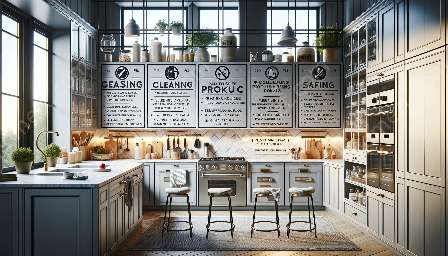It's every parent's priority to keep their children safe, and one of the most important areas to focus on is the kitchen. Childproofing the kitchen is essential in creating a secure environment for your little ones while allowing them to be a part of the family's cooking and dining experiences. In this comprehensive guide, we'll explore essential tips and strategies to childproof your kitchen effectively, taking into account kitchen safety and creating a family-friendly space.
Understanding the Importance of Childproofing
Before diving into the specifics of childproofing your kitchen, it's crucial to understand the importance of this task. The kitchen is typically filled with potential hazards for young children, including sharp objects, hot surfaces, small choking hazards, and toxic materials. By childproofing the kitchen, you can minimize the risk of accidents and create a safe space for your kids to explore and learn while developing a love for food and cooking.
Evaluating Kitchen Hazards
When childproofing your kitchen, it's essential to identify potential hazards that could pose a danger to your children. Some common hazards include sharp knives and utensils, hot surfaces such as stovetops and ovens, electrical appliances, cleaning supplies, and small objects like nuts and candies that could be choking hazards. By evaluating these hazards, you can develop a targeted childproofing plan to address each concern effectively.
Essential Childproofing Tips
1. Cabinet and Drawer Locks
Install cabinet and drawer locks to prevent children from accessing potentially harmful items such as sharp objects, cleaning supplies, and small kitchen gadgets. There are various childproofing locks available, including magnetic locks, latches, and sliding locks, which can be installed easily and provide effective protection.
2. Stove and Oven Guards
Consider installing stove and oven guards to block access to hot surfaces and prevent accidental burns. These guards can be heat-resistant and act as a physical barrier, keeping children at a safe distance from the stovetop and oven while cooking or baking.
3. Safety Gates
If your kitchen has an open layout, installing safety gates can help restrict access to the kitchen area, especially when cooking or working in the kitchen. Safety gates can be particularly useful for homes with toddlers who are eager to explore and may be at risk of entering the kitchen unsupervised.
4. Child-Friendly Kitchen Tools
Introduce child-friendly kitchen tools and utensils to encourage your kids' involvement in cooking activities while ensuring their safety. Consider using plastic or nylon utensils, as well as child-sized knives and peelers that are designed to be safe for young chefs.
Kitchen Safety Practices
In addition to childproofing measures, practicing kitchen safety is crucial for maintaining a secure environment for both children and adults. Incorporate the following safety practices into your kitchen routine to further enhance safety:
1. Supervision and Education
Always supervise children in the kitchen and educate them about potential hazards and safe behaviors. Teach them about using oven mitts, staying away from hot surfaces, and the importance of not touching electrical appliances without supervision.
2. Secure Electrical Outlets
Use outlet covers and safety plugs to prevent children from accessing electrical outlets and potentially harming themselves with electrical devices or appliances.
3. Safe Storage of Hazardous Items
Store hazardous items such as cleaning supplies and sharp objects in secure, high-up locations that are inaccessible to children. Consider using childproof containers for storing potentially harmful substances.
Creating a Family-Friendly Kitchen
While prioritizing safety, it's important to create a family-friendly kitchen that welcomes children and promotes joyful cooking and dining experiences. Consider the following tips for a family-oriented kitchen:
1. Designated Child's Space
Create a designated area within the kitchen where children can safely engage in cooking and baking activities. Set up a low countertop or table with child-friendly kitchen tools and utensils to encourage their participation.
2. Childproofed Dining Area
Extend childproofing measures to the dining area, ensuring that dining chairs are stable and secure to prevent tipping over. Additionally, avoid using tablecloths or placemats that children could pull on and cause items on the table to fall.
3. Educational Resources
Display educational resources such as food charts, kitchen safety tips, and child-friendly recipes in the kitchen to foster a learning environment and encourage children's interest in food and cooking.
Conclusion
Childproofing the kitchen is a fundamental step in creating a safe and welcoming space for children to explore and engage in cooking and dining experiences. By understanding the importance of childproofing, identifying kitchen hazards, implementing essential childproofing tips, and practicing kitchen safety, you can establish a family-friendly kitchen environment that prioritizes the well-being of your little ones. Embrace the joy of cooking and dining together as a family while ensuring a secure and supportive space for your children's culinary adventures.





















